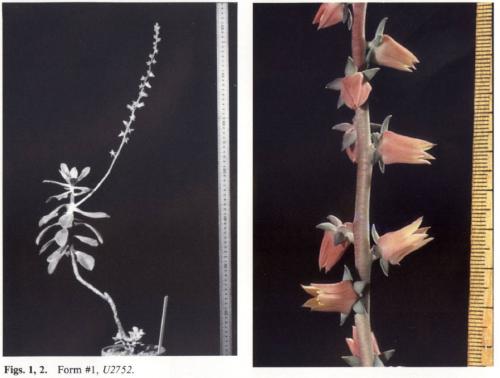Form #1
Distribution : Form #1 is perhaps the most common Echeveria in Venezuela. It is centered in the Andes of western Venezuela, particularly in the western part of the state of Mérida and in adjacent Tachira. Most populations occur on rocks among low bushes and other growth at elevations of 1700 - 3200 m and three collections from much lower elevations near Lagunillas, downstream from the city of Mérida at an elevation of only 900 - 1000 m.
Typical E. bicolor from near Caracas has leaves that are green and often shiny and never more than slightly glaucous. Form #1 differs from this most conspicuously in its very blue-glaucous leaves, although occasional individuals in some populations have leaves that are green and not glaucous. Form #1seems to be more closely related to Form #2 than to the typical green-leaved E. bicolor.
Description by Ch. Uhl in Cactus and Succulent Journal US 65(2): 81-83. 1993 :
Leaves oblanceolate to spatulate and tend to be shorter and stiffer than in typical E. bicolor, the largest on a plant averaging (in 13 collections) 55 mm long x 27 mm wide, as opposed to 70 x 25 mm in my lone collection of the typical form of the species. Leaves of some plants and populations have narrow pale or reddish margins, especially distally.
Pedicels mostly 2 - 5 mm long, with two very small bracteoles 2 - 5 mm long (vs. 8 - 10 mm in typical E. bicolor) that very often dry and fall before anthesis (vs. more persistent). In some collections the pedicels bend to change the vertical orientation of the buds and flowers or to turn most or all flowers toward the same side.
Sepals generally 4 - 6 mm long, and always spreading nearly or completely at right angles to the corolla.
Corollas generally a bit smaller than in the typical form, and usually pale yellowish to dull orange, flushed outside with variable amounts of rose (vs. a definite reddish flush in the typical form).

Photos by Charles Uhl, Cactus and Succulent Journal US 65(2): 82. 9193.